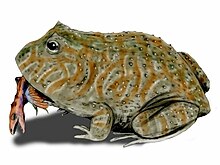Beelzebufo
| Beelzebufo | ||||||||||||
|---|---|---|---|---|---|---|---|---|---|---|---|---|

Skeletal reconstruction of Beelzebufo ampinga . |
||||||||||||
| Temporal occurrence | ||||||||||||
| Upper Chalk | ||||||||||||
| 70 to 65 million years | ||||||||||||
| Locations | ||||||||||||
| Systematics | ||||||||||||
|
||||||||||||
| Scientific name | ||||||||||||
| Beelzebufo | ||||||||||||
| Evans , Jones & Krause , 2008 | ||||||||||||
Beelzebufo ampinga (= "armored deviltoad", from Beelzebub = devil, Bufo ( Latin ) = toad, ampinga ( malagasy ) = shield ) is an extinct frog thatlivedin Madagascar in the Upper Cretaceous about 65 to 70 million years ago.
Fossil description
The frog's remains were first discovered in 1993. In total, more than 60 individual bones were found in the Maevarano Formation on Madagascar at 26 sites within a radius of 1.8 kilometers, including skull fragments and almost all parts of the postcranial skeleton. Beelzebufo's sturdy, heavily ossified skull was eight inches wide and wider than it was long. The connection between the upper jaw and the skull was particularly stable. The animal reached a length of more than 40 centimeters; so it was larger than the longest recent frog, the African goliath frog ( Conraua goliath ).
Systematics
Beelzebufo is similar in its morphology to today's South American horn frogs ( Ceratophrys ). It is placed as its sister taxon together with these in the subfamily Ceratophryinae . His way of life probably also resembled that of his current relatives; accordingly Beelzebufo lived terrestrially ; the animals probably buried themselves too. The strong jaws and sharp teeth suggest that Beelzebufo also ate small vertebrates. Its bite force of up to 2200 Newtons corresponded to that of today's wolves or female tigers.
Naming
The scientific name Beelzebufo is made up of the Hebrew name “ Beelzebub ” for devil and the Latin name “ Bufo ” for toad . This is to refer to the special size and appearance of the amphibian. The type epithet ampigna means “shield” in Malagasy and refers to the ossified skull of the animal and the Malagasy site.
Importance of the fossil record
Today the Madagascar frogs (Mantellidae), narrow-mouth frogs (Microhylidae) and reed frogs (Hyperoliidae) are the only frogs in Madagascar. There are no longer any horned frog relatives that were only known from South America until this discovery . The discovery of Beelzebufo is an indication that a land connection between South America via the Antarctic to South Africa or Madagascar could have existed in the Cretaceous Period .
source
- Susan E. Evans, Marc EH Jones, David W. Krause: A giant frog with South American affinities from the Late Cretaceous of Madagascar. In: Proc. Natl. Acad. Sci. UNITED STATES. doi: 10.1073 / pnas.0707599105 (abstract)
further reading
- S. Evans, J. Groenke, M. Jones, A. Turner, D. Krause: New Material of Beelzebufo, a Hyperossified Frog (Amphibia: Anura) from the Late Cretaceous of Madagascar. In: PLOS ONE. 2014. doi: 10.1371 / journal.pone.0087236 . PMID 24489877 .
Web links
Individual evidence
- ^ AK Lappin et al. (2017): Bite force in the horned frog (Ceratophrys cranwelli) with implications for extinct giant frogs Scientific Reports 7, Article number: 11963. doi : 10.1038 / s41598-017-11968-6
- ↑ Daniela Zeibig (2017): Huge primeval frog could once have eaten dinosaurs . Spektrum.de . Last accessed on December 23, 2017
